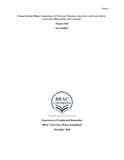| dc.contributor.advisor | Mahbub, Rifat | |
| dc.contributor.author | Nabi, Papiya | |
| dc.date.accessioned | 2017-02-27T09:10:40Z | |
| dc.date.available | 2017-02-27T09:10:40Z | |
| dc.date.copyright | 2016 | |
| dc.date.issued | 2016-11 | |
| dc.identifier.other | ID 13263012 | |
| dc.identifier.uri | http://hdl.handle.net/10361/7791 | |
| dc.description | This thesis is submitted in partial fulfillment of the requirements for the degree of Master of Arts in English, 2016. | en_US |
| dc.description | Cataloged from PDF version of thesis. | |
| dc.description | Includes bibliographical references (page 51-53). | |
| dc.description.abstract | Literary adaptation has reached a new dimension specially from the postmodern era. The process of adaptation has gone through many technical and aesthetic changes over the last few centuries. And the changes vary from the classical piece of literary to the contemporary texts as well. Film industries around the globe has been inspired by the idea of adaptation, and because of this interest in new innovation, such as books adapted into motion picture or vice-versa relation between the two forms of art. This trend of adaptation has flourished over time, and nowadays not only films are being adapted from classics or popular literature but literatures are also inspired by films and are made into written piece of art based on a film or television drama. These adaptations have lively impact on both medium of art, cultural perception and the recipient. Ever since recreation and entertainment through film and TV’s has become an important part of our daily life, the practice of adaptation demands more new vibrant cultural re-reading and research to establish the prospect of adaptation in the new era. My study will look into the variety of classical adaptation of novels into screen, the difference in the introduction of the cinema from the text, the issue of fidelity and its impact on adaptation and film making, the prospect of modern technology and improvised camera and cinematographic work, and last but not least the changing form of culture. | en_US |
| dc.description.statementofresponsibility | Papiya Nabi | |
| dc.format.extent | 53 pages | |
| dc.language.iso | en | en_US |
| dc.publisher | BRAC University | en_US |
| dc.rights | BRAC University thesis are protected by copyright. They may be viewed from this source for any purpose, but reproduction or distribution in any format is prohibited without written permission. | |
| dc.subject | Pride and Prejudice | en_US |
| dc.subject | Jane Eyre | en_US |
| dc.subject | Great Gatsby | en_US |
| dc.subject | Film | en_US |
| dc.subject | Fidelity | en_US |
| dc.subject | Character analysis | en_US |
| dc.title | From texts to films: adaptations of Pride and Prejudice, Jane Eyre and Great Gatsby across the 20th and the 21st centuries | en_US |
| dc.type | Thesis | en_US |
| dc.contributor.department | Department of English and Humanities, BRAC University | |
| dc.description.degree | M.A. in English | |

